Archive for ‘Paper Organizing’ Category
Paper Doll Shares 12 Kinds of Paper To Declutter Now
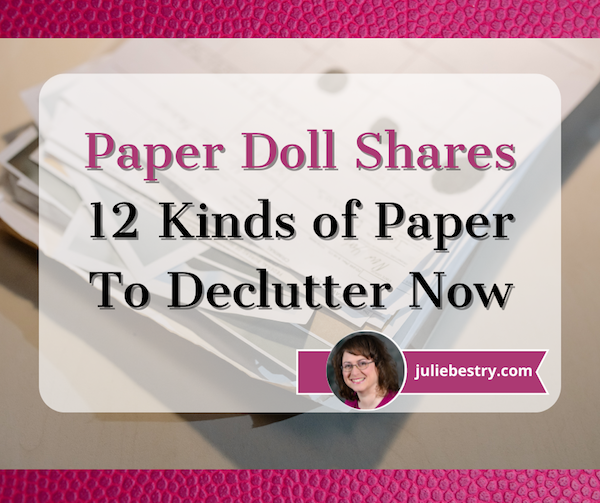
After last week’s 24 Smart Ways to Get More Organized and Productive in 2024, we continue with GO Month, an entire month devoted to getting organized and being productive. I thought it might be time to hit a classic Paper Doll topic topic: decluttering papers!

Quite often, Paper Doll focuses on the papers and documents you need to acquire and keep. Always start with the essentials:
How to Replace and Organize 7 Essential Government Documents
How to Create, Organize, and Safeguard 5 Essential Legal and Estate Documents
The Professor and Mary Ann: 8 Other Essential Documents You Need To Create
Ask Paper Doll: Do I Really Need A Safe Deposit Box?
However, we must also look at what we no longer need, and what papers we’d be better off without.
OLD RECEIPTS
Some people throw out all of their receipts. Their desks, bags, dresser-tops and bedside tables are clear of crumpled papers, but they have trouble reconstructing their financial history at tax time, they can’t figure out where their cash went, and can’t prove ownership or value of high-ticket items.
More often, people go to the opposite extremes and keep all of their receipts. When working with clients, I’ll often find zip-locked bags and drawers filled with random receipts. In addition to receipts strewn about, the collected and squirreled-away receipts tend to be older, anywhere from a year to five+ years in the past.
These clients have a vague sense that someone once told them to save receipts in case they needed to return something or create a budget based on tracked expenses. The problem? Neither of these well-intentioned reasons are based on a realistic view of their paper-cluttered lives.
Yes, you should hold onto receipts for purchases you might return, but most return policies that limit how long after the purchase something may be returned. In general, you’ll need the receipt to return something for a full refund for up to 30 days after purchase; after that, the best you can hope for at most retailers is store credit. (Stores vary, and Nerd Wallet has a great piece, Return Policy Guide: What to Know and Which Stores Stand Out, on the most generous return policies at stores like Costco, Kohl’s, and IKEA.)
Similarly, if you were going to track your expenses to create a budget, receipts from years ago won’t help now. Paper Doll gives you permission to start fresh with January (and last week’s receipts) and let go of the bulk of your random receipt clutter.

Woman with Receipts Photo by Karolina Grabowska at Pexels
Reasons to Keep Receipts
There are five main reasons to keep receipts, and none are “forever” reasons:
1) The item is returnable — only keep the receipt until the return period ends.
2) It’s a big-ticket item — keep a Big-Ticket Purchases folder for these kinds of receipts in your financial filing section.
Figure out your comfort level to determine whether “big-ticket” is $50 or $500 or $5 zillion; if the receipt is above a certain threshold, you may want to add a rider to your homeowners or renters insurance policy.
The IRS allows taxpayers to choose between deducting state taxes and sales tax; if you opt for sales tax, the default amount is often the wisest option; however, you’ve purchased a house, auto, boat, private plane, or personal rocket ship, you’ll definitely want proof of that big ticket deduction.
3) The receipt helps you prove ownership. This tends to go along with Big-Ticket items, as you’ll rarely be asked to prove that the soon-to-be-moldy asparagus in your fridge actually belongs to you.
4) The receipt is for something tax-deductible. Non-business purchases are more likely to be deductible if they’re related to healthcare, government fees or taxes, child/dependent care, or tax credits for things the government is trying to promote, like environmentally beneficial or energy efficient home improvements.
5) The purchase will be reimbursed by someone (employer, insurance company, etc.) at a later date.
Additionally, if you’re divorcing and seeking alimony and/or child support, you may need to collate receipts to prove the costs of life maintenance.
Here are some basic guidelines for the receipts you can discard, with a few caveats.
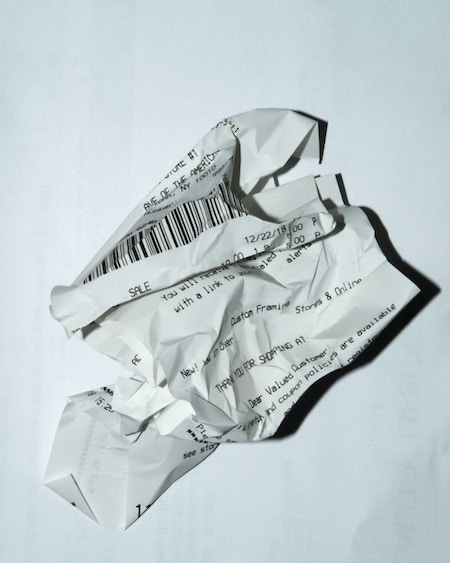
Crumpled Receipt Photo by Michael Walter on Unsplash
Cash Receipts
- Let go of cash receipts for consumable products (like food and beverages) whenever you want. If you’re not tracking expenses, you can toss them immediately. You can even refuse to accept receipts.
If you buy a Slushie at 7-Eleven or a burrito at the taco truck and pay with cash, you’re generally safe tossing receipt — unless you watch too many Law & Order reruns and are convinced you need to be able to prove your time-stamped whereabouts at all times.
- Keep cash receipts for things you might return, but only for the duration return period. After the return policy, buh-bye!
For example, if you buy clothes, a toy, or anything for your home, car, or family with cash, keep a plain #10 envelope to stash purchase receipts. Keep the envelope near where you handle your daily finances so that you know where to find receipts if you need to make a return.
Set a reminder, perhaps on the 5th of every month, to flip through the receipts. Once past the store’s return policy, shred the receipt.
The above assumes you’re not buying fancy-pants, expensive things with cash (and that you are not a member of a Sopranos-style crime family. If you are, please confer with your accountant.)
Debit and Credit Card Receipts
- Keep debit and credit card receipts until the return period has expired and you’ve eyeballed your statement or online account to verify that the final price is accurate.
As with cash receipts, pop credit card and debit card receipts in that #10 envelope. If you get paper statements for your bank and credit card accounts, reconcile the values monthly when your statements arrive. If you no longer get statements, reconcile receipts against your running online account weekly.
Deposit Slips and ATM Withdrawal Slips
If you think about it, a deposit slip is really a receipt, only instead of paying a store or service provider for what they’ve given you, you’re paying the future version of yourself who will spend that money later.
As for the five reasons to keep receipts, none particularly apply here. If you wanted to return the cash you withdrew, you could do that without the ATM slip, and taking or giving back your own money doesn’t involve tax deductions. Reimburse-ability doesn’t apply. The “big ticket” status isn’t applicable with withdrawals (as banks limit how much you can take out in one day); deposits are a little stickier, as there’s a paperwork rigamarole to go through if you ever deposit more than $9,999.99.
Of course, if you’re sort who worries about that pesky Law & Order issue regarding your whereabouts, you might also fear having to prove ownership of the money you’ve withdrawn.
In general, treat these as if they were debit or credit card receipts, and save them until your bank has accurately recorded the information. (But if you are making manual deposits of $10,000 or more, note the purpose, save the receipts, and tuck them in your tax prep folders just in case the amounts are questioned in an audit.)
A Few Other Notes About Receipts
Your pharmacy will print a summary of all prescription purchases. Once you’ve checked your receipts against your bank or credit card statements, you can shred pharmaceutical receipts; just ask your pharmacy to provide printout in early January for the preceding calendar year. (It’s to your benefit to only use one pharmacy so you don’t have to keep track of these things. If you must use a different pharmacy — if you’re on vacation or your regular pharmacy is out of your prescription medication — save those receipts.)
Collect all receipts for tax-deductible expenses (like charitable donations, or medical and pharmaceutical expenses in your Tax Prep hanging folder until you’ve completed your taxes for the prior year. (You won’t know until the end of any given year whether you accumulated a high enough percentage of your adjusted gross income to deduct itemized expenses.)
Keep receipts for anything for which you are due reimbursement until you get paid. This may include:
- Work and travel-related expenses where your company reimburses you. Label a folder “Reimbursable Expenses” and toss receipts in there. Set a reminder on your calendar for the week prior to when expense reports are due, to ensure you don’t put it off and delay recouping your costs.
- Healthcare expenses for which your health insurance company reimburses you. Usually, you pay a co-pay or co-insurance to a healthcare provider, but sometimes providers won’t file insurance claims. You may have to submit documents from the provider, plus your receipt, and forms directly to your insurance company to get reimbursed for medical expenses.
- Sometimes, you’ll need to submit receipts to your car or homeowners/renters policy insurance company for repairs done to your auto or home. You might need to submit receipts to someone else’s insurance company if the other party was at fault. Always keep the original and provide them with photocopies).
If you’re reimbursed for a high-dollar amount for anything unusual, keep the receipt and the proof of reimbursement in your tax prep folder. If audited, it will be easy to say, “Hey, I anticipated that you’d wonder about this! So, here’s the receipt where I chartered a helicopter to get my boss to the top of the mountain for a super-important meeting, and here’s the income you’re questioning, where I was reimbursed for what I paid out.”
Always have a system for collecting your receipts until you get home. Do not stuff receipts in your coat pocket, no matter how many people are behind you in line. Do not put receipts in the shopping bag, because it’s too easy for them to fall out in the car, or for the bag to be discarded with a receipt still inside. Make 2024 the year you resolve not to have any crumpled receipts in your pockets or your car!
[We’ll take a fresh look at digital receipts in a future post, but the rules regarding what you can let go of are the same for digital as paper.]
OLD HOUSEHOLD UTILITY BILLS
It’s common for me to find that clients have saved multiple years of old electric, gas, water, and sewer bills. They shrug. Someone, somewhere, told them they were supposed to save all records.
People’s parents (particularly fathers) rightly told them that it’s important to keep all records regarding auto maintenance. A full and detailed record helps boost the resale value of a car. (Secondarily, if there’s a recall, the car owner can get reimbursed for work previously done.)
The thing is, even if you keep meticulous records, a prospective home buyer isn’t going to offer you more for your house based on ancient utility bills. Knowing what it cost to heat your home in January or cool it in July back in 1992 is not useful information!

Little House Photo by Kostiantyn Li on Unsplash
Keep paper utility statements for the prior calendar year and the current one, just so that you can easily compare year-to-year (for example, to trace the likelihood of a leak vs. “Oh, yeah, July water bills are always high because we use the Slip & Slide). Shred the older ones.
(Note: if you take a tax deduction for a home office for your home-based business, keep utility bills as supporting documents for business tax returns.)
OLD INSURANCE POLICIES
People have a habit of keeping really old insurance policy paperwork.
I advise that if you don’t have any pending claims against your insurer and nobody has a lawsuit against you, it’s OK to shred old declaration pages and toss the generic boilerplate from old home and car policies. You may want to keep the front page of the policy listing the old policy number and contact information for the insurer.
With health insurance policies, if you’ve changed policies recently, I find it’s helpful to keep the paperwork related to coverage you had in the prior calendar year. While medical providers are supposed to process claims within 90 days, I’ve seen where physicians’ offices were so disorganized they were trying to recoup fees (either through insurance or directly from patients) more than a year later. Keeping the essential info about the policy can help if you get caught with “zombie” claims. But policies older than the prior calendar year, unless you’re still fighting about claims, can be shredded.
One insurance policy caveat: If you cash in a life insurance policy, either for the cash value or after someone has passed, make sure you log that you have done so. I’ve worked with clients where there’s been great excitement upon finding old life insurance policy paperwork, only to learn the original policy holder cashed in the policy up to 50 years earlier, but never destroyed or discarded the old paperwork. Bummer.
For clarity, if you cash in a policy, make a note somewhere accessible (like your inventory of assets and debts) so that your future fuzzy brain or your inheritors can make sense of what happened.
EXPIRED WARRANTIES
If the warranty or guarantee period has already expired, toss out the warranty/guarantee card. (If it was a bigger ticket item and you’d stapled the receipt to the warranty card, make sure the receipt gets saved.)
If you no longer even own the product associated with the warranty or guarantee, dunk it like a basketball! Swoosh! (But shred the receipt.)
MANUALS FOR THINGS YOU DON’T OWN (AND SOME YOU DO)
If you don’t own the thing anymore, you don’t need the manual!
If you own the thing, but know how to use it, you don’t need the manual! (I often joke that if you don’t know how to use your toaster or hair dryer, you have a bigger problem than clutter.)
For guidance, there are ways to pare down and organize your manuals, find digital alternatives, or even digitize your collection to help keep things streamlined:
Paper Doll’s Manual Override – Part 1: Declutter and Organize Owner’s Manuals
Paper Doll’s Manual Override – Part 2: Twelve Resources To Find An Owner’s Manual
Paper Doll’s Manual Override – Part 3: Create & Organize A Digital Owner’s Manual Library
OLD DRIVING DIRECTIONS MADE REDUNDANT BY GPS
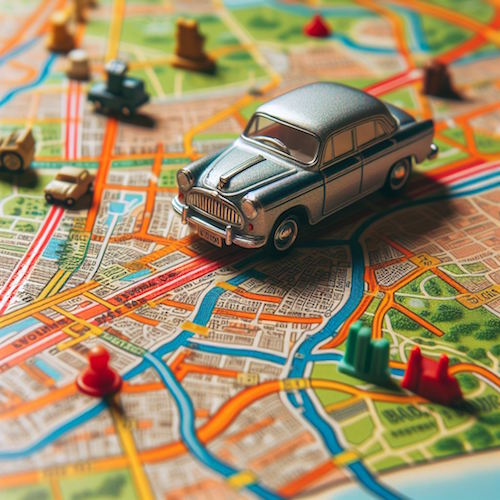
As you go through your files and piles of old papers, you may find driving directions to anywhere from hotel venues to summer camps to doctor’s offices.
If you’re never going there again, toss the paper. If Siri or Google Maps can get you there, toss the paper. If there’s anything special about the directions (maybe for the last tenth of a mile) and you could get the information again easily, toss the paper. If that last bit of the trip requires special instructions, create a contact (for the venue, the camp, or the office) in your phone and put those final, special directions in the “Notes” field.
DUPLICATE DOCUMENTS
Have you ever accidentally printed a copy of something multiple times and kept the copies? If the item is a form or a template you have to share (physically) with others and can’t just forward a digital file, make a folder. But if you just have random duplicate or triplicate or seventeenplicate of something you printed for no discernible reason, recycle or shred, as applicable.
OLD BOARDING PASSES
Yes, most of us now use digital boarding passes, but if anything changes about your flight, the nice typey-typey airport people will give you a new set of paper boarding passes. When you get home, don’t toss them in a pile with other crumpled receipts. Old boarding passes are of no future use to you. Shred them!
FYI, those QR codes along the edges have all sorts of personally identifiable information about you. They may not be useful to you, but leaving them out on your desk for anyone to find makes it easier for someone to purloin that information.
OLD CONFERENCE PAPERS AND BINDERS
Not all conference material is created equal. Go through your old conference binders and folders, especially those from early in your career. Be ruthless about letting go of handouts and notes related topics that no longer interest you or fields of study in which you never worked, or never intend to work again.
Trust that any information you want can be found again, and found more easily than spelunking in piles of old binders in the back of a closet.
Similarly, get rid of flyers, programs, and any other conference materials that don’t contain essential information.
JUNK MAIL
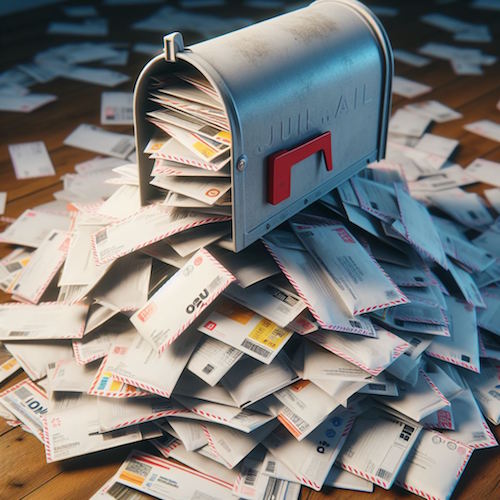
Did you ask for it? Do you want or need it? No? It’s junk! Instead of letting it pile up, shred it and sent it on its way. To stop junk mail in its tracks:
- Opt out of credit card and insurance offers for 5 years by going to optoutprescreen.com or call 1-888-5-OPT-OUT (1-888-567-8688), operated by the major credit bureaus. You’ll have to supply personal information like your name and address. They’ll also ask for your Social Security number and date of birth; it’s optional, and they’ve always claimed it’s confidential, but this is the 21st-century, so who knows?
- If you prefer to opt out permanently, start the process at optoutprescreen.com or call 1-888-5-OPT-OUT, but to complete the request, they’ll make you sign and return a Permanent Opt-Out Election form.
For other kinds of marketing junk mail, register at the Direct Marketing Association’s (DMA) consumer site, DMAchoice.org and pay a $4 processing fee for ten years of protection from most (but not all) junk mail.
OUTDATED, LOW-QUALITY, OR IRRELEVANT INFORMATION
I once worked with a (very) organized author. I initially joked that I wasn’t sure how I could help, as her office seemed orderly and tidy. However, when we looked in her files, I saw the problem.
The client wrote novels with storylines that included medical information, so she’d saved a few decades of internet printouts regarding diagnoses and treatments of various conditions. In almost every folder, any clip from the web from more than two or three years earlier was completely outdated. While some fields may include timeless information, research related to the sciences is likely to be superseded by newer data and analysis each year.
Unless your actual job description requires analyzing what used to be advised or believed vs. what is now known to be true, toss the outdated information.
Similarly, let go of any clipped articles or printouts that reflect information you already know (or that has become common knowledge), that has been disproven, lacks credibility, or isn’t related to your work or interests.
Tips from 1999 on traveling to Europe won’t fly (pun intended) in a post-9/11 world, but even advice from pre-COVID may not be valid. Introductory-level parenting articles from when your kids were tiny might have been useful, but if you’re cruising toward grandparenthood, you’ll find guidance has changed. Just let the internet be your filing cabinet!
DAMAGED PAPERS
This should go without saying, but discard any papers that are damaged due to water, fire, or animal predation. Papers with tiny blobs of mold can damage your neurological and pulmonological health. If a piece of paper is readable but yucky, digitize it (but then disinfect your scanner).
FINAL RESOURCES
You’ll be delighted to lessen your paper clutter knowing that much of what you’ve saved (due to misinformation, fear, or just plain inertia) can go. However, anytime there’s anything personally identifiable in your papers, make sure you shred them.
Paper Doll’s Secrets: Shred Successfully & Save Money is a good resource for making it easy to destroy what you don’t need and prevent identify thieves and other sneaky folks from benefiting from your decluttering.

Finally, knowing what to get rid of is only part of the paper decluttering process. For a full-on look at strategies for knowing papers to keep, and for how long, check out my classic ebook, Do I Have To Keep this Piece of Paper.
24 Smart Ways to Get More Organized and Productive in 2024
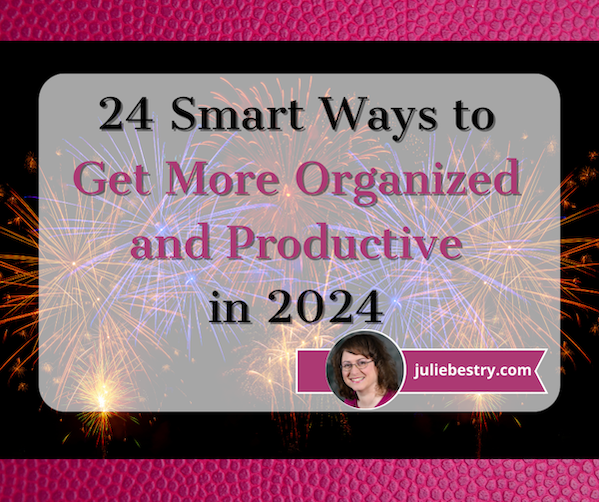
Happy New Year! Happy GO Month!
January is Get Organized & Be Productive (GO) Month, an annual initiative sponsored by the National Association of Productivity & Organizing Professionals (NAPO). We professional organizers and productivity experts celebrate how NAPO members work to improve the lives of our clients and audiences by helping create environments that support productivity, health, and well-being. What better way to start the year than creating systems and skills, spaces and attitudes — all to foster a better way of living?!

To start GO Month, today’s I’m echoing Gretchen Rubin’s 24 for ’24 theme that I mentioned recently, and offering you 24 ways to move yourself toward a more organized and productive life in 2024. There are 23 weekdays in January this year, so if you’re feeling aspirational and want to conquer all of these, you can even take the weekends off as the last item is a thinking task rather than a doing task.
I broke these organizing and productivity achievements down by category, but there’s no particular order in which you need to approach them, and certainly you don’t need to accomplish every one on the list, in January or even all year. Jump in and get started — some only take a few minutes.
PUT LAST YEAR AWAY
1) Make many happy returns!
Did you know that shoppers will return $173 billion in merchandise by the end of January? Chances are good that you (or someone for whom you oversee such things) got gifts that need to be returned.
Don’t put it off. The longer you wait, the more clutter will build up in your space, and the more likely you will be to suffer clutter-blindness until the return period has expired. Most stores have extended return policies during the holidays, but they can range upward from 30, depending on whether you have a gift receipt.
The Krazy Coupon Lady blog reviews the 2024 return deadlines for major retailers. She notes that you’ll get your refunds faster by returning items to the brick & mortar stores rather than shipping them back. You’ll also save money, because some online retailers charge a restocking fee.
2) Purge your holiday cards.
While tangible greeting are getting fewer and farther between, you probably still got a stack. Reread them one last time, and then LET THEM GO.

Did Hallmark or American Greetings do the heavy lifting, and the senders just signed their names? Toss them into the recycling bin. Paper Doll‘s grants you permission to only save cards with messages that are personal or resonant.
If they don’t make you cry, laugh, or go, “Ohhhhh,” don’t let them turn into the clutter you and your professional organizer will have to toss out years from now when you’re trying to downsize to a smaller home! It’s a holiday message, not a historical document; you don’t transcribe your holiday phone conversations and keep them forever, right?
The same goes for photos of other people’s families. You don’t have to be the curator of the museum of other people’s family history; let them do that.
3) Update your contacts.
Before you toss those cards, check the return addresses on the envelopes and update the information in your own contacts app, spreadsheet, or address book.
Next, delete the entries for people you’ll never contact again — that ex (who belongs in the past), that boss who used to call you about work stuff on weekends (ditto), people who are no longer in your life, and those who are no longer on this mortal coil.
If you don’t recognize the name of someone in your contacts, Google them or check LinkedIn (is it your mom’s doctor? your mechanic?) and if you still don’t know who it is, you’re obviously not going to be calling or texting them. Worst case scenario, if they text you, you can type back, “New phone, who dis?”
BOX UP YOUR INBOXES
4) Delete (most of) your old voicemails.
How often do you return a call only to hear, “The voicemail box is full and is not accepting messages. Please try again later.” When someone calls you and requests you call them back but their voicemail is full, it’s frustrating because it makes more labor for you.
Do you assume that it’s a cell phone and text them? (I believe texting strangers without permission is a breach of etiquette.) Plan to call back later? Assume that they’ll see the missed call and get back to you, starting another round of phone tag? ARGH!
Dial in to your voicemail and start deleting. Save phone numbers for anyone you’ll need to contact and log anything you may need to follow up on. But unless you’re saving a voicemail for legal purposes or because you can see yourself sitting in an airport, listening to a loved one’s message over and over (cue sappy rom-com music), delete old voicemails.
If you’ve got a landline, clear that voicemail. If you’ve still got an answering machine, how’s the weather in 1997? Yeah, delete old messages.
Smith.ai has a great blog post on how to download important voicemails (from a wide variety of phone platforms) to an audio file. Stop cluttering your voicemail inbox!
5) Clear Your Email Inboxes
Start by sorting your inbox by sender and deleting anything that’s advertising or old newsletters. If you haven’t acted on it by now, free yourself from inbox clutter! Delete! Then conquer email threads, like about picking meeting times (especially if those meetings were in the past).
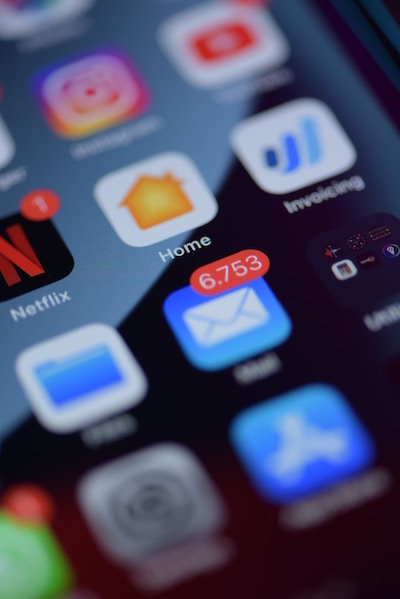
Take a few minutes at the end of each day to delete a chunk of old emails. To try a bolder approach, check out a classic Paper Doll post from 2009, A Different Kind of Bankruptcy, on how to declare email bankruptcy.
6) Purge all of your other tangible and digital inboxes.
Evernote has a default inbox; if you don’t designate into which folder a saved note should go, your note goes somewhere like Paper Doll‘s Default Folder. Lots of your note-taking and other project apps have default storage that serves as holding pens. Read through what you’ve collected — sort by date and focus on the recent items first — and either file in the right folders or hit delete!
Walk around your house or office and find all the places you tend to plop paper down. Get it in one pile. (Set aside anything you’ll absolutely need in the next few days to safeguard it.) Take 10 minutes a day to purge, sort, and file away those random pieces of paper so that you always know where they are.
HIT THE PAPER TRAIL
7) Embrace being a VIP about your VIPs.
You need your Very Important Papers for all sorts of Very Important Reasons. If the last few years have proven anything, it’s that life is unpredictable, so we need to find ways to make things as predictable and dependable as possible.
Yes, putting together essential paperwork isn’t fun. It’s boring. But you want it to be boring. The more boring your vital documents are, the more it means there will be no surprises for your loved ones in troubling times (like during and after an illness, after a death, while recovering possessions after a natural disaster) or even when you’re just trying to accomplish something like getting on an airplane.
Start with these posts, then make a list of any document you already have (and where it is), and another list of what you need to create, and plan meetings with your family and a trusted advisor to set things in motion.
How to Replace and Organize 7 Essential Government Documents
How to Create, Organize, and Safeguard 5 Essential Legal and Estate Documents
The Professor and Mary Ann: 8 Other Essential Documents You Need To Create
Paper Doll’s Ultimate Guide to Getting a Document Notarized
Paper Doll’s Ultimate Guide to Legally Changing Your Name
A New VIP: A Form You Didn’t Know You Needed
8) Create your tax prep folder now so you’ll be ready for April 15th.
Do you toss non-urgent mail on top of the microwave? Might those important 1099s and 1098s and 1095-A and W-2s get lost? Don’t lose deductions, pay more taxes, or get in trouble with the IRS!
By the end of January, you’ll start getting tax documents in the mail. Pop them in a folder in your financial files or in a dedicated holder like the Smead All-in-One Income Tax Organizer.
Recapping Paper Doll’s 2023 Posts — Which Were Your Favorites?

With one week left in 2023, have you taken time yet to review your year?
For the December Productivity and Organizing Blog Carnival, Janet Barclay asked us to identify our best blog posts of 2023, and I had a tough time.
“Best” is subjective, and Janet let us have free reign as to which post fit. Some bloggers chose their most popular posts in terms of readership; others, the ones that garnered the most comments. Some of my blogging colleagues picked their most personal posts, while others selected what they felt would have the most impact on people’s lives.
The problem is that picking just one means leaving the others behind, and I wrote forty-two posts this year! Eventually, I narrowed the selection to half a dozen posts, and then turned to colleagues and friends who were almost evenly split, bringing me no closer to a solution. In the end, I picked Paper Doll On Understanding and Conquering Procrastination because it served as the foundation for so many other posts, but also because I’d been lucky enough to find some great visuals, like this one from Poorly Drawn Lines:
so much to do pic.twitter.com/fiSm7Y2Erg
— poorly drawn lines (@PDLComics) December 21, 2022
Beauty, like clutter, is in the eye of the beholder. To that end, here’s a recap of everything we’ve discussed in 2023, with a few updates and tweaks along the way. My personal favorites are in bold, but I’d love to know which ones resonated the most with you during the year!
ORGANIZE YOUR INSPIRATION
After uploading last week’s post, Toss Old Socks, Pack Away 2023, and Adjust Your Attitude for 2024, I got to thinking about all the different ways we can take our word, phrase, or song of the year and keep it in the forefront of our minds.
I’d reviewed the traditional methods (vision boards, posted signs, turning the song into your wakeup alarm), but felt like there needed to be something that stayed with you, independent of your location. Only being reminded of your goal to be a leader when you’re standing in front of your fridge doesn’t really help you in your 1-to-1 meetings at work. (I mean, unless you’re the Queen of the Condiments or King of the Crisper Drawer.)
Only being reminded of your goal to be a leader when you're standing in front of your fridge doesn't really help you in your 1-to-1 meetings at work. (I mean, unless you're the Queen of the Condiments or King of the Crisper Drawer.) Share on XSerendipitously, within minutes of thinking about this, an ad came across one of my social media pages. (Normally, I ignore ads, but this one had me thinking maybe “serendipity” would be a good theme word for some year!) The ad was for Conscious Ink, an online temporary tattoo retailer specifically for creating body art to help you mindfully connect with your themes and messages to yourself, disrupt negative self-talk, and promote the healthy habits you’re trying to embrace!
As Conscious Ink’s About page explains, if you want to keep something top of the mind, why not try something that keeps it “top of the body?” Whether body art is your thing or you haven’t experimented since your Minnie Mouse temporary tattoo at summer camp <mumble mumble> years ago, this is a neat trick!
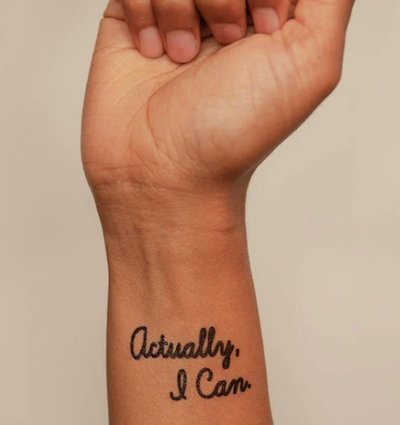
There’s even research as to how a temporary tattoo can support permanent emotional and cognitive transformation and improve mindfulness and focus on things that uplift one’s higher self. And that’s the point of a theme word, phrase, or song, to keep you focused on what you want rather than what you allow to drag you down! Manifest what you want your life to be.
Conscious Ink’s temporary tattoos use non-toxic, cosmetic-grade, FDA-certified, vegan inks. Each one lasts 3-7 days, depending on where you apply it, your skin type and activity level, and (I suspect) how many life-affirming, stress-reducing bubble baths you take. Categories include mindset, health and wellness, spiritual/nature, relationships, parenting, celebratory, and those related to social causes. Prices seem to hover at around $10 for a three-pack and $25 for a 10-pack. There’s even a Good Karma Guarantee to make sure you’re satisfied.
Whether you go with Conscious Ink (which is designed for this uplifting purpose) or seek an alternative or custom-designed temporary tattoo (through vendors like Momentary Ink or independent Etsy shops), it only makes sense if you place it somewhere you can see it often.
After all, if you place a temporary tattoo reminder to stand up for yourself on your tushy, it probably won’t remind you of much. For most of us of a certain age, putting it at our wrists, covered (when we prefer) by our cuffs, will give us the most serene “om” for our buck.
If you place a temporary tattoo reminder to stand up for yourself on your tushy, it probably won't remind you of much. Share on XAlong the same lines as my advice on adjusting your attitude for 2024, you may want to consult Gretchen Rubin’s Tips for Your “24 for 2024” List. Rubin and her sister/podcast co-host always have an inspring Happier Trifecta: a year-numbered theme, along with with a challenge and a list.
PRODUCTIVITY AND TIME MANAGEMENT
This was a big year for productivity discussion. I’m a firm believer that keeping your space and resources organized is key to being productive. However, it’s hard to keep the world around you organized when outside influences prevent you from being efficient (doing things well) and effective (doing the right things).
We continue to see the value of body doubling, whether through friendly hang-outs, co-working (virtually or in person), or professional organizing services, whether you want to conquer garden-variety procrastination or get special support for ADHD.
Partnering for Success
Paper Doll Sees Double: Body Doubling for Productivity (I almost submitted this post to the carnival. Accountability and motivation for the win!)
Paper Doll Shares 8 Virtual Co-Working Sites to AmpUp Your Productivity
If you’d like to explore the body doubling or co-working experience, friend-of-the-blog Deb Lee of D. Allison Lee is offering a no-cost, two-hour Action Day event on Tuesday, January 9, 2024, from 10 a.m. to 12 p.m.

This event is designed for her clients and subscribers, but after a cheery holiday conversation, Deb said it was OK to let my readers know about the opportunity.
Deb describes an Action Day as “personal training for your productivity muscles!”
An Action Day (especially as Deb runs them) is a stellar way to narrow your focus and start taking action on your goals. (And what better time than at the start of the new year?) You’ll get to connect with others who are also working on goals and habits with the support of Deb, a productivity coach I admire and adore.
Just bring your top two or three priorities, and you can conquer anything, like:
- organize your workspace
- write your book outline
- clean up your digital files
- test a new productivity app
- send out client proposals
- anything!
You’ll videoconference with a small, select group via Zoom. Share your goal and tasks, work for the bulk of the two hours, and then take time to debrief and share your successes!

Moving Yourself Forward
Getting anything done involves figuring out what you have to do, knowing what’s kept you from getting started, making it easy for you to begin, and celebrating even the smallest wins. These next three posts were where the magic happened this year!
Paper Doll On Understanding and Conquering Procrastination (This is the post I submitted to the Productivity & Organizing Carnival.)
Frogs, Tomatoes, and Bees: Time Techniques to Get Things Done
Use the Rule of 3 to Improve Your Productivity
Dealing with the Pokey Times
If you’re overwhelmed by all you’ve got going on during late December and early January, you can skip onward. However, if your workplace closes down during the holidays, or your professional and personal lives just feel like they’re kind of in a slump right now, you may find some inspiration in two pieces I wrote for the summer slowdown.
The weather outside may be frightful (unless you’re reading from Australia), but if you are looking for ideas to pump you up when everyone is in a post-shopping/meal/travel haze, these posts may stir your motivation:
Organize Your Summer So It Doesn’t Disappear So Quickly
Use Your Heart, Head, and Hands to Organize During the Slow Times
Try To Do It All (And Knowing When to Step Away)
Maybe you did your annual review and found that you’re feeling burned out. If so, you are not alone. It’s easy for your groove to turn into a rut, and for all of your drive to accomplish come crashing down because you never take your foot off the gas all year!
If you missed these posts earlier need a second shot at embracing the importance of variety, small breaks, and actual vacations, here’s your chance to read some of my absolute favorite posts of the year:
Paper Doll Says: Don’t Get Stuck in a Rut — Take Big Leaps (Be sure to watch the diving board video!)

Was baby Paper Doll burned out? In a rut? Just pooped?
Take a Break — How Breaks Improve Health and Productivity
Take a Break for Productivity — The International Perspective (This is the post that introduced the Swedish convivial snack break, fika!)
If you had any doubts about what I said about the importance of taking breaks in your day to refresh your body, your brain, or your spirit, a new report just a few weeks ago confirms that we need that late afternoon break if we don’t want our productivity to turn to mush! And the more we push ourselves beyond work hours, the greater our decrease in productivity!
If you’re desperately in need of a full break, but are suffering from decision fatigue and don’t have the energy to begin planning a whole vacation, there are options to make it easier for you. In the BBC’s piece, Why 2024 May Be the Year of Surprise Travel, you may find some rousing options.
Need a little inspiration to spend your holiday gift money on experiences rather than tzotchkes? Check out Time Out’s 24 Best Things to Do in the World in 2024 to envision where you could take long breaks to refresh yourself. Those vintage trains in Italy are calling to me, but perhaps you’d prefer the immersive “Dream Circus” in Sydney, Australia, or Montréal en Lumière’s 25th anniversary?
(Never mind, I know. Everyone wants to go on the Taylor Swift cruise from Miami to the Bahamas. Just come back with good stories instead of memento clutter, OK?)
TOOLS AND IDEAS FOR GREATER PRODUCTIVITY
Sometimes, rereading my own posts reminds me how many nifty things there are to share with you, and how many are still to be discovered.
Paper Doll Helps You Find Your Ideal Analog Habit Tracker — So many people have requested a follow-up covering digital habit trackers, so watch for that in 2024.
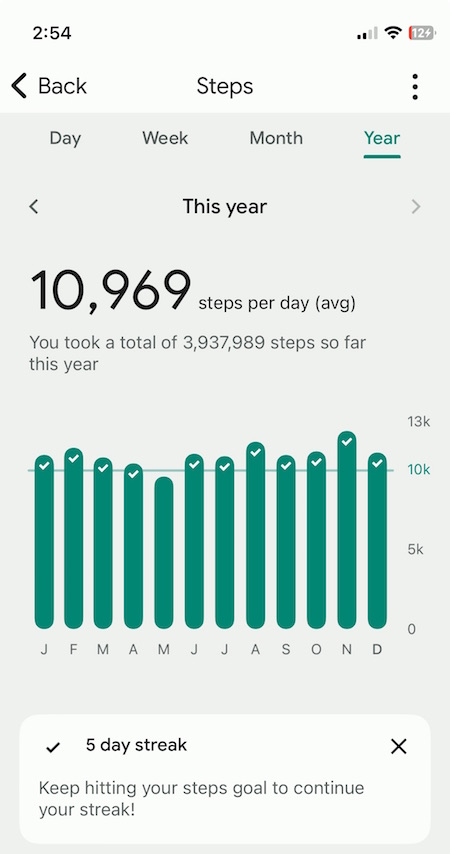
Paper Doll Presents 4 Stellar Organizing & Productivity Resources
Paper Doll Shares Presidential Wisdom on Productivity — From the Eisenhower Matrix to Jefferson’s design for the swivel chair, from limiting wardrobe options to understanding the difference between being busy and being productive, we’ve had presidents who have known how to get more (of the right things) done. With an election year in 2024, I’d love a debate question on the candidate’s best tips for staying organized and productive!
Surprising Productivity Advice & the 2023 Task Management & Time Blocking Summit
Highlights from the 2023 Task Management & Time Blocking Summit
3 Simple But Powerful Productivity Resources — Right in Your Browser Tab — The offering that got the most attention this year was definitely Goblin.Tools. I’m sure that as we head into 2024 and beyond, I’ll be sharing more resources that make use of artificial intelligence.
Let’s just remember that we always need to give precedence to our own intelligence, in the same way we can’t follow GPS to the letter if it directs us to drive in to a lake. In fact, like all organizing and productivity guidance, remember what I said way back in 2020 in The Truth About Celebrity Organizers, Magic Wands, and the Reality of Professional Organizing: there is no magic wand.
AI and other solutions, tangible or digital, and even professional organizers, can make things easier, but the only way to get the life you want is to embrace making positive behavioral changes.
RESOURCES FOR ORGANIZING YOUR WORK AND TRAVEL SPACE
Privacy in Your Home Office: From Reality to Fantasy — It’s interesting to see that privacy, and not just in home offices but in communal workspaces, has become a priority again. Check out this recent New York Times piece, As Offices Workers Make Their Return, So Does the Lowly Cubicle.
Paper Doll Refreshes Your Paper Organizing Solutions
Paper Doll Organizes Temporary Papers and Explores Third Spaces — Do you have systems for dealing with your “temporary papers,” the ones that you don’t need to file away but aren’t triggering an immediate action?
Paper Doll Organizes Your Space, Money, and Well-Being While Traveling
Paper Doll is Clearly Organized — Translucent Tools for Getting it Together
Paper Doll Explores New & Nifty Office and School Supplies
Organize Your Desktop with Your Perfect Desk Pad
No matter where I go in 2024, be assured that I will be keeping my eyes open for solutions for keeping your paper and work supplies organized.
My Thanksgiving weekend shopping trips brought me a variety of intriguing options. At Kohl’s, I saw 30 Watt‘s Face Plant, a way to keep your eyeglasses handy while refreshing the air around you (and keeping you perky) with greenery. The 5.5″ x 6″ x 5.25″ ceramic planter holds a plant, gives you a place to rest your glasses (so you won’t misplace them under piles of paper on your desk), and is dry erase marker-friendly! (It’s currently on sale for under $14.)
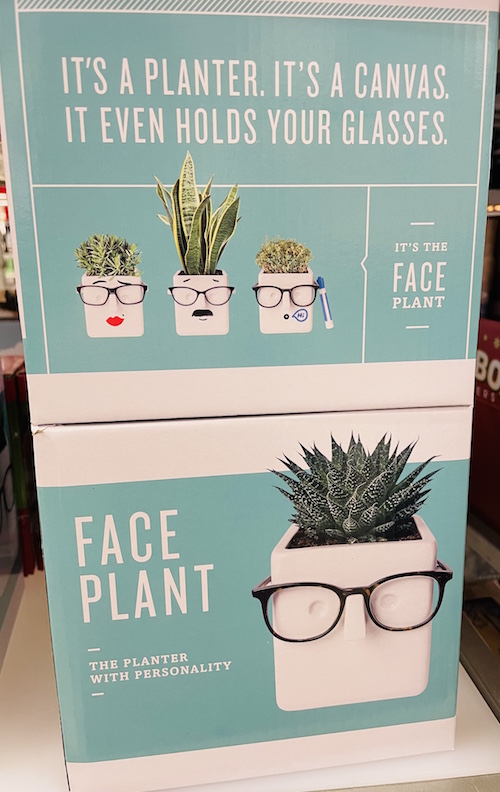
A stop at IKEA in Atlanta was so productive for organizing tools that you’ll be seeing posts with nifty names like Övning (for tidying a child’s desk accessories and creating privacy), Kugsfors (wall-mounted shelves with tablet stands for keeping books and iPads visible while working), Bekant (sit/stand desks) and more.
ORGANIZING YOUR FINANCIAL & LEGAL LIFE
Not everything in the organizing and productivity world is fun to look at, and that’s especially true of all the financial and legal documents that help you sleep soundly at night. Still, Paper Doll kept you aware of how to understand and protect your money, your identity, and your legacy.
Speaking of which, if you haven’t created your Apple Legacy Contact and your Google Inactive Account Manager, why the heck not? Use the power of body doubling up above, grab a partner, and get your digital life in order!
Lost & Found: Recover Unclaimed Money, Property, and Savings Bonds
Paper Doll’s Ultimate Guide to Legally Changing Your Name
Paper Doll Explains Digital Social Legacy Account Management
How to Create Your Apple & Google Legacy Contacts
Paper Doll Explains Your Health Insurance Explanation of Benefits
DEALING WITH EMERGENCIES AND STRESSFUL SITUATIONS
Sometimes, I write a post I wish I’d been able to read earlier (like the one on preventing and recovering from a car theft). Other times, like when a friend had a health emergency, or when Paper Mommy had her fall in November, I’m glad the posts already exist. If you missed these the first time around, please be sure to read, share, and bookmark them; think of them as an insurance policy, and let’s hope you won’t need them.
How to Organize Support for Patients and Families in Need
Organize to Prevent (or Recover From) a Car Theft
Paper Doll Organizes You To Prepare for an Emergency
GRAB BACK OF INTERVIEWS, UPDATES, AND PHILOSOPHY
Paper Doll Interviews Motivational Wordsmith Kara Cutruzzula
You already know how beloved my friend Kara Cutruzzula‘s Brass Ring Daily newsletter and Do It Today podcast are at Paper Doll HQ.
After having read and enjoyed Kara’s Do It For Yourself — A Motivational Journal and her follow-up, Do It Today — A Motivational Journal (Start Before Your Ready), I had no doubt that I’d be jumping on her third when it was released in September.
If you haven’t already picked up Do It Or Don’t — A Boundary-Creating Journal, use that Amazon money you almost certainly got this holiday season!
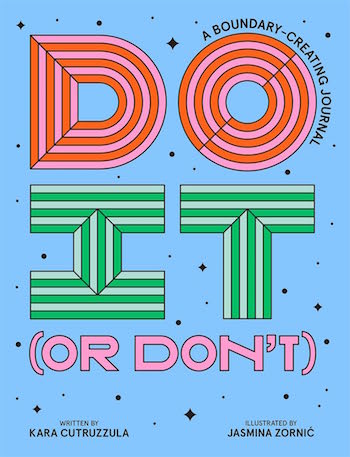 One of the Paper Doll themes for 2024 will focus on setting (and maintaining) better boundaries to accomplish more of what’s meaningful, and I’ve got multi-color tape flags sticking out of Kara’s book from all the chapters to share her bounty with you.
One of the Paper Doll themes for 2024 will focus on setting (and maintaining) better boundaries to accomplish more of what’s meaningful, and I’ve got multi-color tape flags sticking out of Kara’s book from all the chapters to share her bounty with you.
What’s in a Name? “Addressing” Organizing and Productivity
Paper Doll Suggests What to Watch to Get More Organized and Productive — As we head into the new year, I’ll be keeping my eyes open for podcasts, webinars, and TV shows to help you keep your space organized, your time productive, your finances orderly, and your life joyous. Readers have been sending in YouTube and TikTok videos that inspire them, so please feel free to share programming that you’d like to see profiled on Paper Doll‘s pages.
Paper Doll on How to Celebrate Organizing and Productivity with Friends
Paper Doll and Friends Cross an Ocean for Fine Productivity Conversations
From in-person get togethers with frolleagues (what my accountability partner Dr. Melissa Gratias calls those special folks who are both friends and colleagues) to Friday night professional organizer Zooms, accountability calls, and Mastermind group collaborations, this has been a great year for staying connected and sharing the benefits of those conversations with you.
I also loved guesting on so many fun podcasts related to organizing, productivity, technology, and more. If there’s someone you’d like to hear me debate or banter with, let me know!
SEASONAL POSTS
Spooky Clutter: Fears that Keep You from Getting Organized
Paper Doll’s Thanksgiving Week Organizing and Productivity Buffet
Paper Doll De-Stresses Your December
Paper Doll on Clutter-Free Gifts and How to Make Gift Cards Make Sense
Are you stressed out because you haven’t gotten someone a gift yet? Maybe a good start would be to help an overwhelmed special someone take my advice about going on a travel break. Consider gift certificates for something like Get Your Guide, with opportunities to get guided tours of locally-vetted, expertly-curated sporting, nature, cultural, and food experiences. With 118,000 experiences in 150 countries, pick a multiple of $50 or set your own amount, and your recipient can pick the domestic or international travel experience that fits best.
If you know your recipient will be traveling by rail, consider a gift card for Amtrak or ViaRail in North America. Eurail doesn’t sell gift cards, but you can pay for a pass, or buy a gift card for a rail pass for more than a dozen specific European train lines. And if you’d like to help someone organize vacation serenity and secure a bundle of travel attractions for a given city, try TurboPass in Europe or City Pass and The Sightseeing Pass in North America.
HERE’S TO A MORE ORGANIZED AND PRODUCTIVE 2024
Whether you’ll be spending the next few days reading, traveling, or doing your annual review, I hope this last week of 2023 is a happy and healthy one.
To send you off for a cozy week, I’d like to share a Whamagaddon– and Mariah–free, retro 100-minute holiday playlist from the late 1930s through the early 1960s. It’s somehow easier to dismantle the tree and write thank-you notes to Guy Lombardo. (My favorite clocks in at 52:42 with “What Are You Doing New Year’s Eve?”)
Please let me know your favorite Paper Doll posts from this year, and I’ll meet you back here in 2024!
Toss Old Socks, Pack Away 2023, and Adjust Your Attitude for 2024
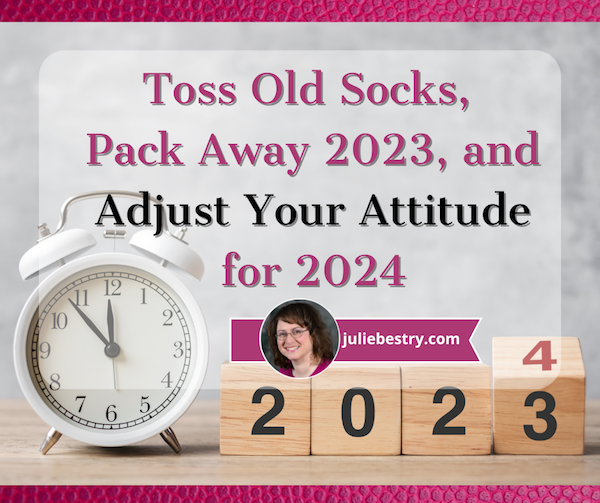
I don’t know about you, beloved readers, but 2023 has been a rollercoaster.
In January, someone rang my doorbell late at night to tell me they’d hit my car in the parking lot; in August, my car was stolen. And in November, just ten days before she was set to join us for Thanksgiving, Paper Mommy fell and fractured her pelvis in two places, and then developed pneumonia 48 hours later, and complications after that! (As of this weekend, she’s finally home and recovering.)
I’m a positive person, but when the TV ads promote stage productions of Annie and the music swells for “The Sun’ll Come Out Tomorrow,” I’ve been struck by a powerful urge to throw the remote through the screen.
Professionally, 2023 was a mixed bag. I’ve maintained and added wonderful clients to my roster, and had a dazzling variety of in-person and virtual speaking engagements. But I was also saddened when a cherished elderly client passed away, and I must confess to not having made any headway on a passion project I’d wanted to write.
This is the traditional time to look back and pack away the prior year and set the tone for the one to come.
Letting go of what’s awful or unnecessary comes as second nature to professional organizers; it’s almost therapy to us. For example, I’m not much for Black Friday, but I used the opportunity to replace almost all of my socks with snazzy new ones and jettisoned the old, sad ones. I’m ready for a new foundation, literally and figuratively.
Evaluating and state of a hosiery drawer and replacing all of hole-y socks is easier than doing a deep dive into how we’ve lived our lives over the past year and designing change for the coming one, but they are similarly life-affirming and necessary.
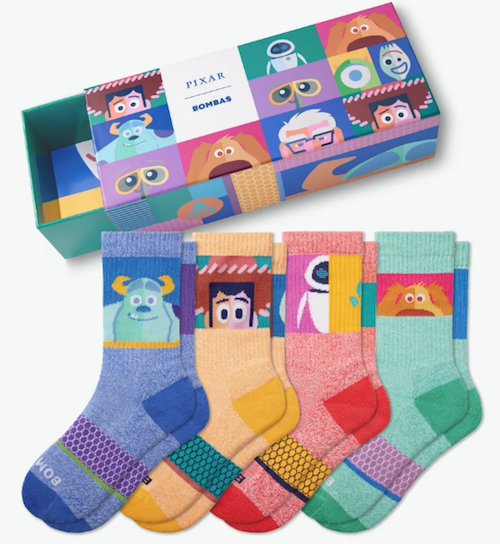
Editor’s Note: if you want to feel doubly-good about getting new socks, consider Bombas, which donates a pair to unhoused individuals for every pair you buy, or John and Hank Green’s Awesome Sock Club, where 100% of the profits go to a charitable organization working to decrease maternal and child mortality in Sierra Leone.
LOOK BACKWARD AND EMBRACE THE PERSONAL ANNUAL REVIEW
There are myriad ways to reflect on your past year, with multiple purposes. The main categories you might want to consider are:
- Health — Please don’t focus merely on weight, but consider stamina and strength, lab results, mental health, and health-related habits (both positive and unsavory).
If you don’t know how you’re doing in these areas, calling to make appointments with specialists and getting a handle on your numbers and benchmarks is a good place to start in the new year.
Don’t have a primary care provider or dentist or OB/GYN? Behind on your immunizations or age-appropriate health screenings like mammograms or colonoscopies? Make 2024 the year to catch up on your adulting! (In 2022, I finally got my overdue tetanus booster, an important one for professional organizers. We never know when something sharp is going to jump out and bite us!)
- Finances — Your bank balance doesn’t tell the whole story.
Did you stay within your budget? (Do you actually have a budget?) Are you comfortable with your rate of savings over the past year? Did you make good or bad investments (or avoid signing up for that 401K at work because you didn’t understand how it worked)?
Is your credit score trending up or down? Are there mistakes on your credit reports, or have you not even checked AnnualCreditReport.com since before the pandemic…or ever?

Dollars Photo by Alexander Grey on Unsplash
- Professional Development — If you work for someone else, prepare for your company‘s annual review (likely done on your work anniversary) by asking:
- What were the top projects I worked on this year in terms of financial return or impact? Am I happy with my contributions? Did I meet expectations? Exceed them?
- What achievement am I most proud of? Where did I fail to hit the mark of expectations, either my own or the company’s?
- What do I wish I had known or done earlier in the year to have improved my performance? What training, skills, knowledge, resources, or support do I need to make my performance next year better?
- Business — If you own your own company, business development means all of the professional development category, plus a much more detailed analysis. Look at all of your goals, not only to see if you achieved them, but to understand how you can improve their specificity, measurability or relevance the next time around.
Do you know where your clients or customers came from? Do you know how satisfied they are with your service or products? What are your metrics for sales, followers on your social media platforms (and interactions with those followers), newsletter subscribers, and your standing in the community?
Competition doesn’t matter as much as client satisfaction, but neither matter if you have no idea how your company (of one employee or one thousand) is trending.
- Relationships — Nobody can tell you what your relationships should be, but if you’re not feeling loved and supported most of the time in your interactions with your partner, family, and friends, it probably won’t get better on its own. Organizing relationships matters!
Identify areas of improvement, like better communication or ways to nurture one another and connect. Maybe you just need to cook and eat meals together, which a recent study has found leads to well-being.
Perhaps you need to consider whether this relationship has outworn its welcome. Just as with clutter, people buy into the sunk-cost fallacy; instead of throwing good money (or time) after bad — whether it’s an outgrown/defective car, gadget, or relationship — sometimes the best thing we can do is break free of inertia and let it go! (Cue Frozen!)
- Intellect and Education — What did you learn in 2023? What did you read or listen to that made you better at what you do or in terms of who you are? Students get report cards; as adults, it’s harder to evaluate our intellectual growth.
Try writing reviews of the books you read or tracking them in a notebook, or online in an app like Goodreads. (With only two weeks to go, I doubt I will hit my Goodreads Challenge goal of 39 books this year; I’m at 28 and will probably only finish two or three more. But that’s probably more than I’d finish if I didn’t keep track.)
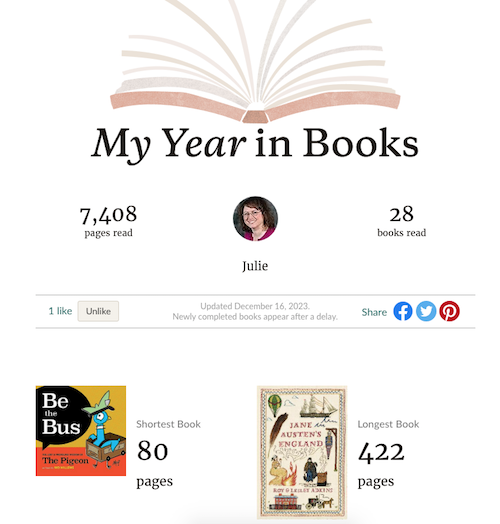
- Personal Growth — What’s different about you now versus last January? Have you grown in any way that’s discernible to your others or yourself? Did you embrace any new hobbies or skills?
If you’re happy with your life, huzzah! But if you feel like there was something missing in 2023, or if you participated in activities that no longer float your boat, now’s the time to explore and set some goals with actionable benchmarks for enriching your life. Make time for hobbies and passionate pursuits, and make room in your schedule for serendipity to offer you surprises!
- Community — Do you have a community outside of your work? Whether it’s social, political, charitable, spiritual, or otherwise, do you feel like you were involved in something bigger than yourself this year? How (and with whom) do you want to move forward next year?
WHAT TO DO WITH WHAT YOU LEARN FROM YOUR ANNUAL REVIEW
Knowing how you did is only the first step. Next, focus on three activities: Celebrate, Acknowledge, and Grow!
Celebrate
When I worked in television, I had a wonderful general manager who used to say, “One ‘Aw, <bleep>!’ wipes out ten ‘Atta-boys!'”
While his salty statement was designed to address public perception, it also calls to mind that even if we celebrate our successes in the moment, when we sit down to evaluate how we’ve done, we tend to focus on our failures and our shortcomings. With the perspective of weeks and months, we can revisit the areas of our lives where we’ve done well (or at least we did better than circumstances might have otherwise allowed).
Go through your calendar, emails, and task lists and find the wins! And because we can be unreliable narrators of our own lives, ask your partner, closest friends, mastermind group, and/or colleagues. You may be delightfully surprised by the successes you’ve forgotten while focusing on the day-to-day or even the fumbles.
Acknowledge
Yes, we do fumble. At work, with our families, with our promises to ourselves. We fail to aspire by believing we cannot succeed in organizing our spaces or our time or our lives, or we aspire without realistic planning, writing checks our overwhelmed future selves can’t cash.
The point isn’t to get mired in where we’ve fallen short, but to cash in our reality checks, measure our ending points against our starting visions, giving ourselves credit and then acknowledging what we must do differently. Do we need new goals and aspirations, or do we need to seek professional help, comradeship/support, and different tools?
Grow
There is little point to looking back as a pure exercise unless we plan to sit on our laurels or self-flaggelate. Instead, we should use the knowledge of our past year to determine what we want our next year to reflect. Often misquoted or truncated, there’s an excellent quote by Dr. Maya Angelou:
“I did then what I knew how to do. Now that I know better, I do better.”
After evaluating your year, ask yourself how you want to do better. Do you really want to lose weight to hit an arbitrary number on the scale, or do you want to feel more comfortable and more confident in your clothes? Do you want to jump on the fitness trend everyone else is trying or do you want to explore something that fits your needs and workout style?
I recently learned that our ability to get off the floor by ourselves, without using our hands, is highly correlated with longevity. So, even though I start every year wishing I were good at yoga (and not both klutzy and bored to tears by it), for 2024, I’m looking at continuing my 10+K walks, getting back into Pilates, and exploring functional workouts designed to help improve stability and strength. I’m also giving myself a benchmark date by which if I haven’t gotten into a regular routine beyond walking, I’m going to hire a coach to guide me on functional aging skills.
If you aren’t happy about (or aren’t feeling informed on) your finances, start by gathering intelligence. Your credit cards likely have a dashboard that sorts your expenditures into categories you can evaluate, like restaurant service delivery or monthly fees for apps you’re no longer using. Look for “spend analyzer” or “year-end summary” on your financial account apps to note trends. If you’ve been using Mint as an independent financial dashboard, note that Intuit is suspending it and moving some (but not all) of its functions to Credit Karma, so you may need to find an alternative.
PICK YOUR ANNUAL REVIEW STYLE
I know from experience that I flounder when trying to do a free-form annual review, so over the years, I’ve embraced Year Compass, which I learned about from Janet Barclay. Year Compass is free, downloadable and fillable, printable PDF. (It’s available in translations to dozens of languages.)
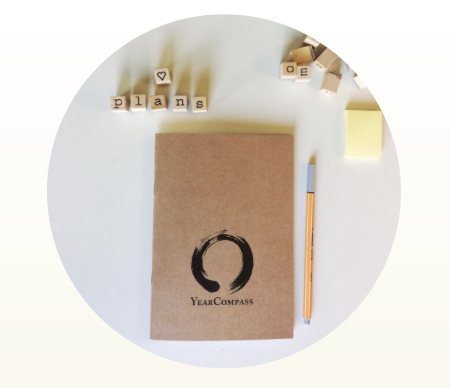
Just print the booklet version and fill it out by hand. (Be sure to set the page to US English to get North American paper measurements.) Alternatively, you can type your answers directly into the digital version. (My penmanship gets more unwieldy each year, but I think we all feel more connection to the past year’s version of ourselves if we hand-write responses.)
Explore the innovative questions to generate a thorough evaluation of how your past year turned out and how to approach the coming year. Do this on your own or with a group of friends or family after a yummy at-home brunch.
In last year’s post, Organize Your Annual Review & Mindset Blueprint for 2023, I talked about the importance of evaluating your year based on your personal values, as well quantitative and my own list of qualitative questions, which I’ll share again:
The Good
- What challenges made me feel smart, empowered, or proud of myself this year?
- What did I create?
- What positive relationships did I begin or nurture?
- Who brought delight to my life?
- Who stepped up or stepped forward for me?
- What was my biggest personal highlight or moment I’d like to relive?
- What was my biggest professional moment I’d want to appear in my bio?
- What’s a good habit I developed this year?
The Neutral
- What did I learn about myself and/or my work this year?
- What did I learn how to do this year?
- What did neglect or avoid doing out of fear or self-doubt?
- What did I take on that didn’t suit my goals or my abilities?
- What was I wrong about?
The Ugly
- What challenges made me feel weaker or less-than?
- Whom did I dread having to see or speak with this year?
- Who let me down?
- Whom did I let down?
- What did I do this year that embarrassed me (professionally or personally) or made me cringe?
- When did I hide my light under a bushel?
- What am I faking knowing how how do? — Instead of pretending you know how to do something but are choosing a different path, ask for help. Make decision about what to do from a position of strength rather than weakness.
- What’s a bad habit I regret taking up or continuing?
- Where did I spend my time wastefully or unproductively? (It’s social media. For all of us.)
- Where did I spend my money wastefully or unwisely? (Target? Let’s take a poll. Was it Target?)
WHY LOOK FORWARD?
Unless you’re a fourth grader watching the clock tick down until recess, time moves too quickly. We have little opportunity to savor the good, and before we know it, the years have flown by. If I don’t plan for how I want to live my future, time will go by without achieving what I want. To remind myself of the brevity and value of each day (without getting too maudlin), I use the simple but motivational app Life Clock.
Life Clock, available for iOS and Android, envisions a lifetime as the equivalent of a 24-hour clock. You feed it limited personal information and it extrapolates your life expectancy (though you can always adjust the number). It then identifies, for the given date, what “time” it is in your life.
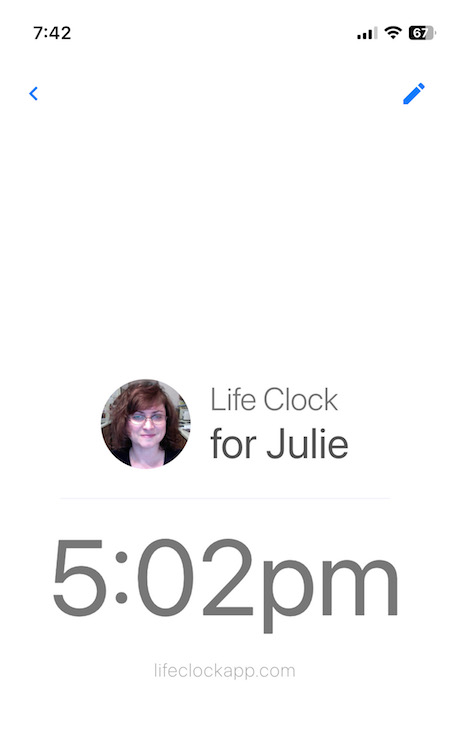
Gulp!
Life Clock shares mini-facts about how to extend your lifespan (and notes what shortens it), and details historical trends and where traditional benchmarks (like graduating and moving out of your family home) fit on the clock of life. Each minute of your “life clock” equals about 20 days in real life.
We don’t need to “optimize” every bit of our lives; we deserve downtime. But we only get 1440 minutes in a real day, so let’s not waste a single one of our life clock minutes on things that aren’t good for us and don’t make us happy.
Nobody gets to decide for you what matters most. That said, it’s hard to stay focused on what matters to you when kids and world events and who Taylor Swift is dating all get in the way.
RESOLVE TO GIVE UP RESOLUTIONS
As I’ve written for many years, I don’t think resolutions work; they lead to disappointment and frustration. Why?
- People set unrealistic expectations. Resolutions are often overly ambitious and fail to account for the time and effort you need.
- Not all goals have to be SMART goals, but if your resolutions lack specificity (“get out of debt” or “get it shape,”), you have no actionable steps to take.
- Most resolutions have no real plan of action and no method for achieving accountability.
- Far too many resolutions have no intrinsic motivation. If your resolutions are designed to make someone else happy (whether that’s your mother-in-law or society) or compete (with a societal ideal or another individual), you’re bound for misery. I prefer SMARTY goals that are specific, measurable, achievable, relevant, time-based, and most importantly, yours.
- Too many resolutions are made and evaluated with all-or-nothing thinking. Success based on perfectionism is demotivating. Give yourself grace.
Instead of resolutions, focus on changing your habits. I’ve written about this at length, including in Organize Your Life: The Truth About Resolutions, Goals, Habits, and Words of the Year back in 2019 and earlier this year in Paper Doll Helps You Find Your Ideal Analog Habit Tracker.
So read those two posts, and for real, meaningful change, read Charles Duhigg’s The Power of Habit: Why We Do What We Do in Life and Business
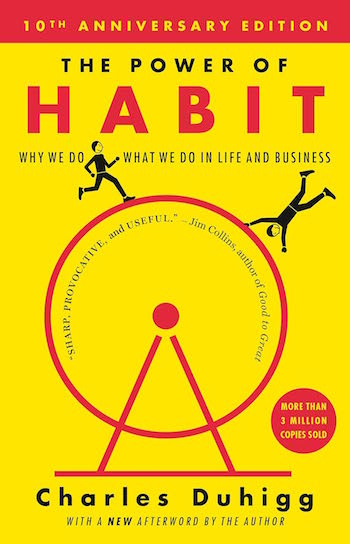
and James Clear’s Atomic Habits: An Easy & Proven Way to Build Good Habits & Break Bad Ones.
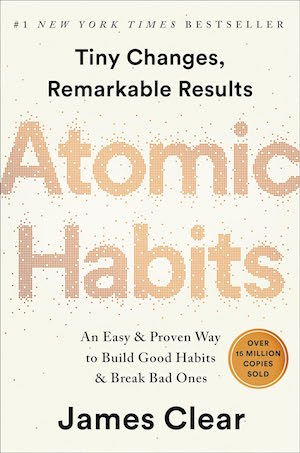
We don’t change who we are just because we decide to. We need a game plan. I will never embrace brevity in talking or writing. I will never be a morning person. But, I can change my habits. And so can you.
PROMOTE YOUR 2024 PLAN TO YOURSELF
Along with habit changes instead of resolutions, I believe in boosting your mindset so you can remind yourself, regularly, that you want to live a certain way, and why.
In the annual review/forward-looking posts I’ve linked to throughout this post, I’ve done deep dives into ways to keep the motivation and energy of your “why” alive. You can read about them in detail, but they include:
- a word of the year
- multiple words (like a trio of words) of the year
- a quote or motto or mantra of the year
- a song of the year
Whatever you pick, this word or phrase or song is your personal theme for the coming year. It reflects what you want to remember about your goals and your attitude. We all know that advertising works, so whatever you pick, or however you combine these ideas, use your (organized) space to keep your attention on your intention for the year.
Promote your theme word or phrase or song — to yourself — on a vision board to reflect and encompass any or all of your motivating words, phrases, and songs. Post your message to yourself on your bathroom mirror, your fridge, the inside of your front door — anywhere that it will give you a boost! Change your wakeup alarm on your phone to your song theme!
PAPER DOLL’S WORD OF THE YEAR FOR 2024
Some years, I do better than others with my word choice. In 2020, I picked “ample” and embracing the phrase “Ample: it’s not just for bosoms anymore.” I’ve carped about how the “ample” opportunities for experiencing a global health crisis weren’t appreciated, but upon years of reflection, I did grow the virtual organizing and productivity coaching side of my business.
2021’s “delighted” kept me seeking opportunities for delight, but I never managed to find a word that fit well for 2022. This year, I chose “fulfilled,” and it was a guiding principle behind work and life choices.
So far, I have two contenders for 2024.
One option came to me mid-summer in a flash, so I wrote it on the December page of my calendar so I wouldn’t forget. The word is UPGRADE.
I have a habit of overthinking a word’s unintentional implications. (Like how the year I picked “resilient,” I ended up with too many things from which to bounce back.)
Upgrade, though, has real potential. While there might be a slight implication of expense — having to replace things — I really feel the vibe of improvement. This isn’t about upgrading tangible things (socks notwithstanding) but about the quality of my experiences.
But “upgrade” has a quirky competitor: PRONOIA.
Don’t worry if you’ve never heard of it. Honestly, the first time I heard the word, I assumed it was made up. It’s opposite of paranoia; a person experiencing pronoia believes that the world around them conspires to do them good. Obviously, taken to extremes, it might seem like psychological or spiritual irrationality.
But Buddist principles haven’t been working for me, I’m still trying to get a handle on the Stoics I talked about in Toxic Productivity Part 2: How to Change Your Mindset. I feel the pull of a bigger change in my life, and I think “pronoia” dovetails with the idea of a life upgrade.
Thus, I keep coming back to the Carly Pearl song in which I first heard the word “pronoia.”
While song is about psyching oneself up after a heartbreak, there’s something in the lyrics (and Pearl’s intonations) that I find inspiring.
You ever heard the word Pronoia?
It’s the opposite of paranoia, pronoia
The belief that the world conspires in your favor
Honey, it’s a game changer
It’s a cherry lifesaver
When I feel like everything is breaking down
It’s the dip before I hit the higher ground
(©2023 Carly Pearl, Renee Hikari, and David Baron)
How do you feel about the year that’s ending? What word or phrase or song is emblematic of what you want in 2024?
Paper Doll on Clutter-Free Gifts and How to Make Gift Cards Make Sense
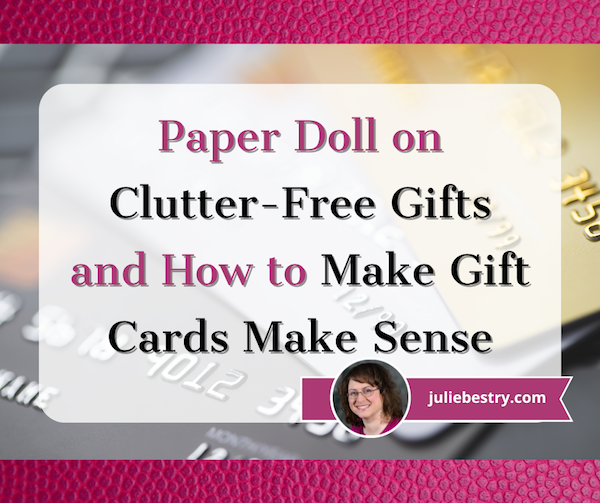
Chances are good that you’ve got three things on your mind right now: shopping for holiday presents, trying to keep your shopping and your budget organized in this most expensive of months, and dealing with the fact that — holy canoli! — the year is almost over! Paper Doll can’t stop time, but I’ve got some ideas for the first two.
EASY-TO-BUY EXPERIENTIAL HOLIDAY GIFTS
Almost every year since I began writing this blog, I’ve sung the praises of experiential gifts rather than tangible ones. The social-psychological research is sound — experiential gifts are both more memorable and more satisfying.
Memorable
With rare exceptions of special surprises and greatly anticipated gifts, we tend not to remember the tangible stuff we get. (This also means we often don’t remember the gifts we’ve bestowed on others; my organizing clients and I have discussed how we’ve received quite a few “repeats” from well-intioned loved ones.)
Tangible gifts rarely take us out of the way we live; they fit into the lives we already lead. We may be changing what we’re wearing or how we’re cooking or what we’re playing with because the new gift varies the activity (as an accessory), but experiential gifts are uniquely different from how we spend our everyday lives. Participating in an experience changes our cognitive and physical lives in a few ways.
Part of the fun is anticipatory. When we get a tangible gift, we unwrap it and then…what? Maybe we’ll use it, maybe we’ll put it away until we think of wearing it or using it (or attempt reading the manual to learn how to use it). But when we get a gift of an experience, from the time we receive the gift card or certificate or gift announcement, we begin anticipating everything it involves. We research and get a sense of what might happen. Our imaginations take the gift we receive and add flourishes to what has been given to us.
When we get a gift of an experience, we begin anticipating everything it involves. We research and get a sense of what might happen. Our imaginations take the gift we receive and add flourishes to what has been given to us. Share on XGive someone a gift that allows them the excitement of anticipating the experience on top of the experience itself and it will be a gift that delights on the holiday, during the intervening period until the experience, and then later in retrospect in the relived and shared memories of the experience. Whoohoo! Now compare that to a sweater or a gadget (if your recipient hasn’t specifically asked for a sweater or that gadget) and you can see how an experiential gift is more nuanced and layered.
Uniquely Satisfying
Experiential gifts are unique. Human beings are social animals and even when we don’t intend to be, we are competitive. We log onto social media, see what our co-workers or our exes’ new partners got for gifts and we compare. Even if we loved our gifts before we logged on, if they got a fancier upgrade or a snootier brand, our holiday cheer is just a bit tarnished. Even if our tangible thing is somewhat superior, the excitement doesn’t last.
However, we don’t compare experiences in the same way. Even if we both went to the same escape room or to Las Vegas or on a cruise, the variables — who we’re with, the weather, our moods, etc. — are going to be so different that there’s no valid comparison. Our experiences are unique to us.
Reviewing Experiential Gifts
Over the years, I’ve collected so many examples of experiential gifts in each category that in 2022 I had to split my traditional post into two (also enormous) posts. I’ve checked (and, where necessary, updated) the links, so rather than give you all the options over again, I’ll just point you to the general categories you can find in those two posts (with a teeny bit of commentary).
Paper Doll’s Ultimate Guide to Clutter-Free Experiential Gifts: Educational
This set of experiential gifts included a wide variety of classes and lessons, including:
- Learn by doing (like music lessons, performance classes like singing or dancing, physical fitness training, horseback riding, language learning and practice, cooking, and food and wine tours). I’m still engrossed in my learning of Italian, having hit 1975 days straight in practicing.

My colleague Maria White of Enuff With The Stuff in Reston, Virginia asked me on social media, “How does it feel to be in the 1% class?” and I replied, honestly, that “I feel like the smartest 56-year-old in a class of preschoolers.”
I may never learn the future conditional tense well enough to respond aloud quickly, but I can suss out a good smattering of what’s written on the web site for L’Associazione Professional Organizers Italia, aka: The Italian Association of Professional Organizers. Grazie mille, Duolingo!
- Learn for the delight of knowledge — This covered educational opportunities for those on your list who miss school and are charmed by an online academic setting. I loved the Jane Austen class I was gifted from The Great Courses a few years ago, and I’d be delighted if I got a Master Class subscription so I could take James Clear’s just-added Small Habits class.
Paper Doll’s Ultimate Guide to Clutter-Free Experiential Gifts: Adventure, Practicality & Pampering
- Gifts of adventure — Whether your (or your giftee’s) idea of adventure is physical exertion in the great outdoors (of which Paper Doll is not exactly a fan), indoor physical adventures that guarantee you won’t get eaten by wolves (like axe-throwing or trampolining) or something more physically sedate but intellectually adventurous (like an escape room), there are options galore.
- Gifts of practicality — Don’t pooh-pooh practical gifts as ho-hum. Obviously, you have to know your recipient. (For example, gifting Paper Mommy a new spring and mattress for her 40th birthday was not one of my father’s wisest moves.) Giving gifts of home care or car care, or coverage of monthly costs (like internet, cable, streaming, digital backup, or video conferencing) can be a boon that lets your recipients spend their (possibly limited) money on ideal needs and wants.
(For what it’s worth, I am a longtime user of Backblaze‘s backup services, and just got an email saying that if you sign up via my Backblaze referral link between December 15, 2023 and January 31, 2024, you get a free trial month. (It’s usually two weeks.) That’s kind of like a gift for all you readers. Disclaimer: If you end up buying Backblaze services, I’ll get a free month, too!)
- Gifts of pampering — Modern life is hard. Everyone deserves gifts that make it (or skin or hair) a little softer. The people most in need of pampering are often the least likely to splurge on themselves.
- Gifts of organization — No clutter-free gift advice can go forward without suggesting the services of a professional organizer, whether in-person or virtually. Again, know your recipient if this isn’t something that’s been requested. The magic of a professional organizer’s services is likely to be an appreciated unasked-for gift for a parents-to-be who want to set up a nursery or pals wanting to support a friend setting up a productive office for a new home-based business. The services of a professional organizer as a “gift” from a parent-in-law who tends to harp on the tidiness of adult child’s partner may not be seen in the same light.
So, click on those two Paper Doll posts above and I bet you’ll find perfect clutter-free presents for the harder-to-buy-for folks on your list.
One more advantage of buying these kinds of clutter free gifts? They’re quick and easy to purchase. In almost every case, you can buy these gifts online. In the rare case where a venue requires a purchase in-person, it’s still easier than wending your way through a big box store; whether it’s a salon, store, or event venue, you can generally go to a desk right inside the front door to purchase gift certificates.
MAKE A (SMALL) MOUNTAIN OF MONEY OUT OF A SERIES OF (GIFT CARD) MOLEHILLS
Do you cringe when you think about giving gift cards? Do leftover gift card balances annoy you?
Get Over Feeling that Gift Cards Are Too Generic
Some people hate gift cards because they’re “generic,” as if a gift card that allows someone to get what they like (or love) is more generic than a random picture frame or candle for a recipient who has shown no interest in such things.
Personally, I think gift cards are fabulous because they are less crass than cash.
As an aside, I have no idea why we in Western society consider giving cash as crass for anyone except adorable octogenarian grandparents. Grandmas gift crisp currency to their grandchildren and we grin at the quaintness. I just worked with a client in his 60s, and in a box of clutter we found a birthday card from his mother containing a crisp bill bearing the likeness of Benjamin Franklin!
Lots of people would love to have a little extra cash at the holidays, when they’ve scrambled to purchase gifts for others, especially versus an ill-fitting gift they can’t return.
A nice alternative, when you truly don’t know what someone wants is a gift card that gives someone an opportunity to get exactly what they want. A teenager or college student is probably going to prefer an Apple or Amazon gift card to one for a clothing store that doesn’t sell the style of clothing they and their friends wear. And failing that, gift cards can be re-gifted.
If you know someone whom you fear may not have the funds to fully experience a gift you’d like to give, you can pair a gift with a gift card. For example, perhaps you know someone who’d appreciate a popular new cookbook but might not be able to buy all the special groceries.
One of the most popular (and most highly rated) cookbooks right now is Baking Yesterday: The Best Recipes from the 1900s to the 1980s, based on B. Dylan Hollis’ TikTok account, where he prepares random dishes from the last century, like Depression-era Peanut Butter Bread or 1950s Tomato Soup Cake. His videos are hysterical, and the recipes can be intriguing.
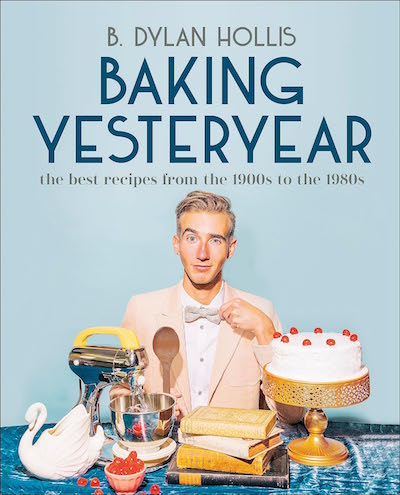
But have you been to the grocery store lately? The average recent college grad probably has a food budget one step up from packets of ramen noodles. Without the funds to make the recipes, this cookbook would just be clutter.
Show your fave wanna-be chefs that you know what’s trendy without bumming them out over their budgets. Pair the cookbook with a gift card for a grocery store near them.
Almost all grocery chains and many local supermarkets offer gift cards, and you can pick them up conveniently when you’re buying you’re own groceries, or purchase them online. If you don’t know which grocery story best serves them, try a gift card for a delivery service like Instacart or Shipt, which covers the cost of the food and store-to-door service.
If your recipient has such a busy life that getting out to buy groceries, let alone having time to prepare and cook meals, is a non-starter, try gift cards for Door Dash or GrubHub. (You can even buy gift cards for these services on Amazon!)
How to Solve the Tiny Denomination Gift Card Conundrum
The one problem with gift cards (for the recipient) is when someone has received a generic cash-like gift card, such as a Visa/Mastercard/American Express gift card. It’s nice to have a gift that can be spent anywhere, but it’s awkward when you have a gift card (or many) with teeny balances. Imagine going to a store, with oodles of people behind you in line, and saying, “I’d like to pay with these seven Visa gift cards, which have balances ranging from $1.43 to $5.87.”
Recently, I received a payout from a class action lawsuit. Usually, the class action funds are sent as small check that you would have felt embarrassed to hand to a bank teller. Nowadays, everyone makes deposits via their phones or at ATMs, sparing us the indignity of having to summon a challenging stare at the teller, telepathically communicating: “Yes, I am going to deposit this check that will barely cover the cost of a soft drink! What of it?!”
This class action check came in the form of a digital code to get a MasterCard e-gift card. In the process of registering, I was given the option to applying the card to my Apple Wallet on my iPhone. I’ve never actually used my Apple Wallet in-person, but figured I could use the e-gift card to pay toward my tiny monthly Apple card expenses (for iCloud and Apple TV).
But guess what? You can’t pay your Apple Card from a gift card in your wallet unless you’re spending at least $10, and the class action money was less than that!
How could I spend that teeny bit of class action money? How could my clients get those minuscule amounts off of their Visa gift cards? How can we stop cluttering wallets (digital and tangible) and drawers with mostly-used Visa/MasterCard/AmEx gift cards?
I’m delighted to tell you that I’ve got a solution I hope you’ll share with others. Did you know that you can purchase Amazon e-gift cards in any denomination from one dollar upward? The process takes a multiple (tiny) steps, but is easy to accomplish.
1) Log into your Amazon account.
2) Go to the Amazon gift card page or type “Amazon gift cards” into the search box.
3) Select the option for Amazon.com eGift Card $1.00 – $2,000. (For me, it’s usually the second option. It looks like this:
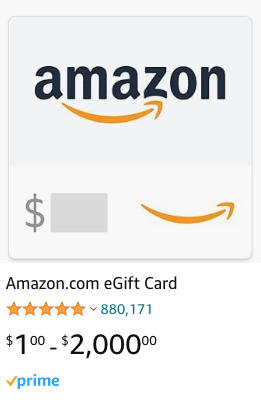
4) On the next page, make a few selections:
- First, it will ask you for what kind of design you want. You’re buying this for yourself, basically just trading gift card credit for Amazon credit, so skip this step and it’ll just apply the default Amazon design.
- On the amount line, fill in the value on the far right, where it says “$ Enter Amount.”
- Fill in the rest such that you’re sending the “gift” from yourself to yourself. It will automatically fill in your name in the “from” section.
- Click “Add to Cart.”
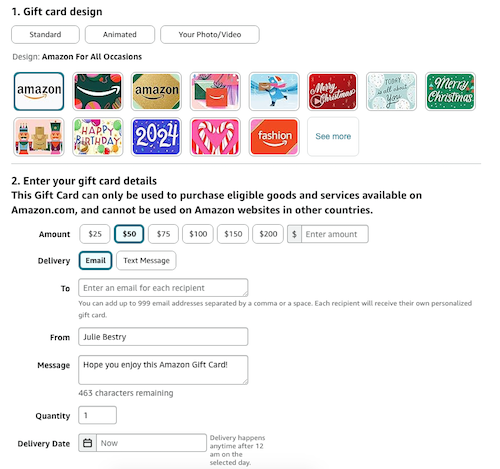
5) Proceed to the checkout page.
- When you go to pay for the gift card, it will ask you to verify the recipient. (Again, it’s you.)
- Then, it will ask you what method you want to use to pay, just as it normally does when you make an Amazon card purchase. This is where you get to “spend” your random Visa/MasterCard/AmEx gift card money. You do this by ADDING the gift card to your Amazon wallet.
- You probably have one or more credit or debit cards and checking accounts listed in this section. Down at the bottom of the “Your Credit and Debit Cards” section, you’ll see where it says, “Add a credit or debit card>Amazon accepts all major credit cards“ — click on it.
- Add the information on the Visa, MasterCard, or AmEx gift card you’re getting rid of. Fill in the number, the security code, and any other information it requests, just as you do when you enter or update credit card information in your Amazon account.
- Once Amazon accepts this as a payment amount, you’re done with the hardest part.
6) Complete your purchase of the Amazon e-gift card as if you were making any other purchase.
7) Wait a few minutes and then check your email. You’ll have received an email telling you that your purchase went through. Hurray! Then you’ll get another email — surprise! — telling you that someone has sent you a gift card.
8) Follow the steps in the email to add the new Amazon eGift Card to your Amazon balance. Usually, you’ll just just have to click a redemption link it’ll be done, but you may have to paste a code from the email into the resulting Amazon page.
- If you never run an Amazon gift card balance, know that the next time you make a purchase, this little amount will be automatically applied and used up, with the remainder charged to your preferred card.
- If, like me, you tend to have lots of random Amazon credit (due to gifts, survey rewards, returns, etc.), this will just increase the total amount of your Amazon balance, which you can always check by going to the Accounts tab when you’re logged in to Amazon and clicking on the Gift Card button. You’ll see your gift card (i.e., account) balance as well as a history of gift card transactions.
Once you’ve done it once or twice, you’ll get the whole process down to about two minutes, not counting waiting for the “Hey, someone sent you an Amazon gift card!” email.
After you’ve completed all of this, and you’ll also get an email telling you that your recipient (again, you!!!) received the gift.
Bonus Tip: How To Delete an Amazon Payment Method
I’ve had clients complain that although they love being able to get rid of dribs and drabs left on generic gift cards using this method, it tends to fill up their Amazon Payments Method section with a mess of random cards that are no longer usable. And it’s not obvious how to remove unnecessary payment methods.
I’ve got a solution for that, too!
If your Amazon Payments Method section is too crowded, you can delete any generic gift carsd you used (to buy the Amazon card):
- Log into your Amazon account.
- Click on Account from the Account & Lists tab dropdown.
- Select the “Your Payments” button.
- You’ll see your Amazon Wallet with all of your payment methods, both the “real” ones you use with your actual debit and credit cards, and whatever random debit or credit card balances you’ve cashed in for Amazon credit.
- For any item you want to delete, click on the card in the column on the far left.
- A graphic of a card will pop up in the center of the page. Click on “Edit.”
- On the resulting screen, you’ll be able to edit the details of the card (name, expiration date, billing address, etc.) or delete it altogether. Click the red “remove from wallet” at the bottom of the pop-up.
You can use this method to get rid of the one-off cards or update any of your regular credit or debit cards, making your Amazon Wallet more organized.
Happy holiday shopping, and please feel free to share these gift card tips with anyone who suffers from a mountain of gift card clutter.



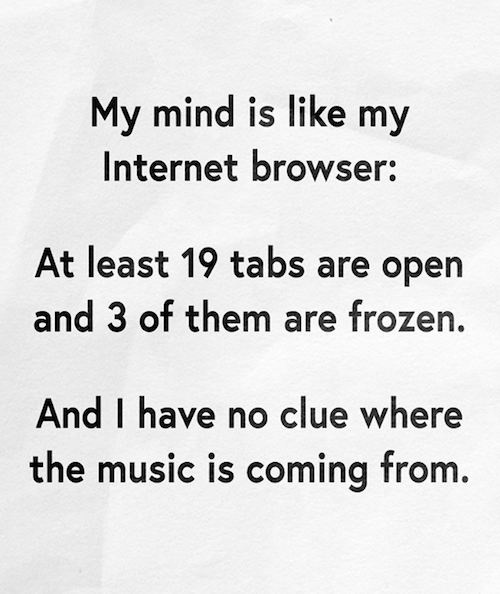
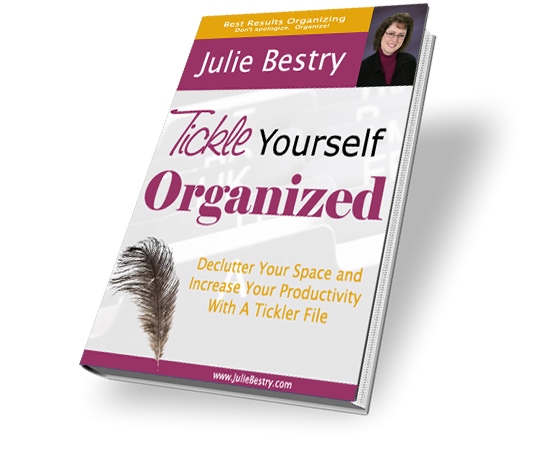






Follow Me